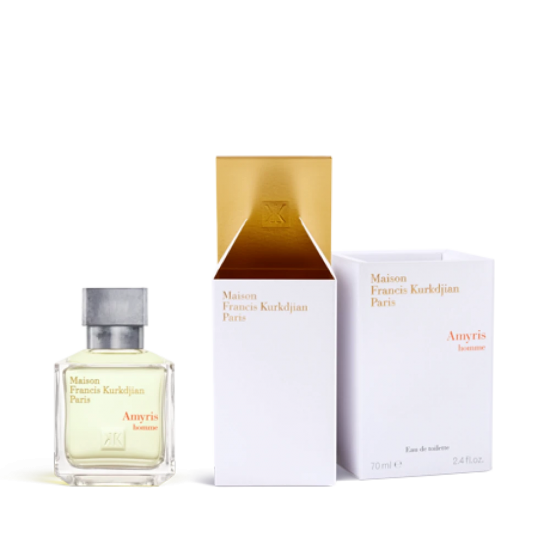











Amyris homme EDT 70ml
150.00€
- Stock:
- Model: 3700559601181
We are an authorized dealer and we guarantee the originality of the offered products.
Free delivery from 50 EUR
When ordering at least one full perfume, we add 3 samples as a gift. *
* Does not apply to orders containing only samples.
* Does not apply to orders containing only samples.
Tags:
70ml
, Agarwood (Oud)
, Amyris
, Coconut
, Coffee
, Fragrances
, Iris
, Men's
, Milk Chocolate
, Rosemary
, Sicilian Mandarin
, Tonka Bean
Amyris homme Eau de Toilette 70ml
Amyris home Maison Francis Kurkdjian eau de toilette for men is a masculine take on the flamboyant pair created by amyris from Jamaica and iris from Florence. Simultaneously fresh and woody, this fragrance places you in a whirlwind of scents, with aromatic notes of mandarin from Sicily and rosemary from Morocco warmed with a tonka bean absolute from Brazil. Amyris eau de toilette for men, a captivating and luminous fragrance
OLFACTORY NOTES
Mandarin from Sicily
At the beginning of January in Sicily, the fields of mandarin trees offer an almost unreal landscape: rows of green shrubs punctuated by orangey-yellow fruits spreading as far as the eye can see between sea and mountains. This Citrus reticulata was imported from Asia at the beginning of the 19th century. According to legend, its name came from its color, identical to the ceremonial dresses of Chinese Mandarins. The fragrant compounds contained in its peel are extracted by cold expression to obtain its oil. This variety has citrusy, zesty but also green, sweet and slightly sulphurous facets. This sparkling and joyful top note enhances a Cologne and energizes an ambery perfume
Rosemary
Endemic to the Mediterranean region, this shrub was already highly prized in the Middle Ages, and cultivated by monks in gardens of medicinal plants; it was used as an antiseptic and a tonic, among other things. Mixed with alcohol, Rosmarinus officinalis was also the major component of the Queen's Eau de Hongrie in the 14th century, renowned for its alleged rejuvenating properties. The oil is obtained after distillation of its blooms. It has fresh, aromatic, herbaceous, camphorated and slightly woody inflections. As a top note, rosemary is used in the composition of some colognes and in many men's fragrances
Saffron
Coming from the pistil of a variety of crocuses, this most expensive spice in the world is nicknamed "red gold". Natural saffron is not used in perfumery because it contains safrol, a highly allergenic compound. But its effect is reproduced with one of its derivatives, saffronal. Its very powerful perfume is bitter and slightly metallic, blowing hot and cold on the rest of the composition with also a leathery, tarred facet. Francis Kurkdjian likes to use it in the top layer of a fragrance to break the sweetness of citrus notes. It is often associated with Oud-based perfumes and amber accords
Amyris
Its name sounds like that of an Egyptian goddess and yet it is native to the Caribbean, and Haiti in particular. There, local fishermen poetically call it "candle wood" because they use it as torches thanks to its highly flammable properties. It is sometimes also refered to as sandalwood from the West Indies. This is probably because once distilled, Amyris balsamifera exhales sweet scents that oscillate between cedar and spicy, slightly smoky sandalwood. A classification among woods that clashes with its botanical genus, the rutaceae family, which also comprises citrus fruits
Cedar from Virginia
This is the typical smell that comes out when you sharpen a pencil: woody, dry, slightly spicy and creamy. This North American cedar, also called red cedar because of the color of its wood, belongs to the juniper family, Juniperus Virginiana. Several types of cedars are used in perfumery, but this one comes into play in the heart and base, which gives a kind of verticality to its woody theme. It is quite different from the other three main varieties used in perfumery, the drier Texas cedar, the animalic and leathery Atlas cedar or the smoky Chinese cedar
Tonka bean from Brazil and Venezuela
This precious raw ingredient comes from the Dipteryx odorata, a tree endemic to Central America and northern South America. Local people have to go into the jungle to pick its ripe fruit once fallen to the ground. After macerating in alcohol and dried, it delivers its kernel, a wrinkled black bean, the tonka. It gradually develops its flavors, including those of its main aromatic molecule, coumarin: powdery, almondy with a freshly mown hay effect, tobacco, slightly honeyed and smoked. Its gourmand facet evokes a slightly vanilla-scented and sweetened shortbread tart. Its absolute, obtained by volatile solvent extraction, is one of the most sensual base notes
Iris
If in the hearts of perfumers the rose is the queen of flowers and jasmine the king, then the iris is the empress. The part utilized in fragrances is not its flower, but its rhizome, i.e. its root. Perfumery uses the iris pallida, native to the region of Florence in Italy. After growing in soil for 3 years, the iris rhizomes are dried and crushed before being distilled to obtain an oil with a thick consistency, also called iris butter. This long transformation process and the very low yield it produces make it one of the most expensive ingredients in the perfumer's palette. The iris extract offers a very special floral note, between the violet and a soft wood, with very powdery and slightly chocolatey, cocoa-like facets. Endowed with exceptional persistence, the iris can be used in minute doses to add volume or in greater quantity to support a floral or woody accord.







